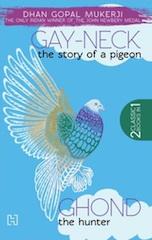
Dhan Gopal Mukerji, the author of the two tales and the only Indian winner of the John Newbery medal, was born in 1890 in a village that straddled the already vibrant city of Calcutta and the deep, untamed jungle of Kajangal. This is good to bear in mind as it not only helps the reader understand his style of storytelling better but also the India that he writes about.
The first novel in this mini omnibus, ‘Gay-Neck The Story of a Pigeon’ is the story of a boy; his beloved pigeon ‘Chitra-Griva’ - meaning ‘painted in gay colours’ and ‘neck’; and Ghond, a master hunter and wildlife expert. The story is filled with their many adventures and deftly moves from the streets of Calcutta to the lush jungles of the Himalayas and even into war torn Europe when Gay-Neck is enlisted as a carrier pigeon during World War I. The author cleverly shifts between using the boy and the pigeon as narrators, providing different perspectives to alternate parts of the story. Through the humans’ narratives, the reader learns about the care, patience and respect required when dealing with animals (a much needed lesson for any child!), while through the pigeon’s narrative, the reader is able to view the world with new eyes, helping to build a more emphatic bond with the natural world around us. This works especially well when the author writes about heavy topics like the predator-prey relationship in nature and war through the eyes of Gay-Neck, perfectly capturing the inherent confusion and fear in a fresh way.
In fact, a running theme in the book is the concept of ‘fear’ - acknowledging it, facing it, and ultimately conquering it. The author shares many insights on this concept using both experience and Buddhist philosophy with an underlying message that works as both advice and a warning - “Whatever we think and feel will colour what we say or do.”
The second novel, ‘Ghond The Hunter’ is written as a letter from Ghond, the master hunter in the previous story. In it, Ghond recounts his childhood and his training as a hunter in a settlement on the edge of the jungle. The book provides a fascinating look at the day to day life in an Indian village and its relationship with the world around. At all times the book portrays the symbiotic way we lived and depended on nature, with the beautifully written philosophy that life is a ‘whole’, where you cannot destroy one species of animal without upsetting all the balance of life. Though the setting may seem like a distant memory in our modern times, the messages still ring true.
Ghond not only shares thrilling stories of the animals he observes and sometimes hunts, but also his experiences growing up in a Hindu village at a time when religion and the caste system dictated the life of the people. While some books of this period tend to either demonise or idealise such situations, Mukerji instead shares the philosophy and history of the common villager while writing in a wonderfully unbiased manner.
Speaking of the writing, the language in the book is wonderful but can be a little confusing for readers used to a less formal way of speaking but, this is more than made up for in the wonderful philosophies shared throughout the book. Another downside is Ghond’s tendency to meander slightly which is in keeping with the concept of the story being told by an old hunter sharing his life experience but may seem slightly confusing for younger readers.This is definitely a book that adheres firmly to the Emerson quote ‘Life's a journey, not a destination’!
Overall both books are a lyrical and exciting read that provides a glimpse into the India that we all come from but are in danger of forgetting - a country that preaches faith, courage, tolerance, and a deep respect for nature.
